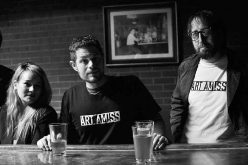The End of the Underground
Saying Goodbye to the Fayetteville Underground
By Blair Jackson
 This Thursday marks the beginning of the end of the Fayetteville Underground. Kicking of its last month as an organization at the First Thursday celebration on the Downtown Square, the Underground will officially disband at the end of December, and though the future of transition is unclear, the artists are confident that the new organization, The Fayetteville Art Alliance, can evolve into something just as powerful as the Fayetteville Underground.
This Thursday marks the beginning of the end of the Fayetteville Underground. Kicking of its last month as an organization at the First Thursday celebration on the Downtown Square, the Underground will officially disband at the end of December, and though the future of transition is unclear, the artists are confident that the new organization, The Fayetteville Art Alliance, can evolve into something just as powerful as the Fayetteville Underground.
The Fayetteville Underground was established in April 2009 with the support of Ted and Leslie Belden, owners of the East Square Plaza building located on the downtown square. In a 2009 Northwest Arkansas Times article, Leslie Belden said that the intent of the Underground was to provide assistance to the artists who were struggling in the recession.
By providing low-cost gallery and studio space for local artists, the Beldens stood at the foundation of the Underground’s development and success. In July of this year, the Beldens decided not to renew the lease, reportedly with intentions to sell the East Square Plaza building that has remained mostly unoccupied.
With the withdrawal of the lease, the Fayetteville Underground board of directors struggled to find a suitable space that would house the artists’ studios as well as gallery space. In addition to space requirements, low overhead and a downtown location were key attributes in the search process. After a short-lived campaign to save the Underground through community donations, the board announced its decision to dissolve the nonprofit organization.

Staff Photo by Blair Jackson: Jan Gosnell sits in his studio, sketching in a book that also contains the words and ideas behind his art.
Before the Fayetteville Underground, there was no home base for professional artists to come together. Jan Gosnell, says he has been creating art since he could hold a pencil and considers himself a compulsive picture maker. He’s also been spent most of his professional career working from a home studio.
“All those years, I was painting by myself in my studio, and I really got out of touch with the art community in Fayettevillle,” says Gosnell. With experience as a successful gallery operator, teacher and independent artist, Gosnell came to the Underground not in search of success, but in search of community and access to other artists.
Gosnell compares his experience at the Underground to his campus life as a graduate student, where artists lived and worked in studios that were located in GI Bill duplexes where the HPER building now stands. Almost three years ago, and 40 years after graduating from college, Gosnell found a similar sense of community in the basement level of the East Square Plaza.
“This is the biggest thing since I’ve seen in Fayetteville, and it’s been the most durable,” says Gosnell.
Bill Flannigan, who has been a Fayetteville artist for over 20 years, and who also graduated from the
University of Arkansas, says being a part of the Fayetteville Underground has been a unique experience of collaboration, osmosis, community and inspiration.
‘I’d never seen anything like it,” he says. “Working side-by-side and appreciating other types of art. There are so many ways that we’ve come together that I’d never seen.” Flannigan notes that in addition to bringing together Fayetteville artists, the Fayetteville Underground brought artists in from around the country and the world.
Like Gosnell, Flannigan spent his artistic life in a more isolated existence before the Underground. Of the art community, he says, “We saw each other once in a while, but I didn’t realize what a community we had here and how lucky we are. “
For Flannigan, one of the most notable elements of the Underground was the feeling of support between the artists. He says that, in the beginning, individual artists came together as individual business owners, which made everyone a little apprehensive; but with a support system that held mutual interest at the highest value, the strength of their community deepened into something that Jan Gosnell refers to as “family.”
Dealing with sensitive professional set backs, such as creative blocks, show rejections, or simply not selling enough art —the artist have gotten to know one another on a personal and professional basis. “We appreciate each other’s work by knowing each other,” says Flannigan.
To see what the group of artists has accomplished, one merely needs to visit the Underground galleries and studios. Using the donated space as an enormous blank canvas, visitors will find professional galleries, welcoming studios and personable artists.
Gosnell says the board and the location helped, but that talented artists who are also “thinkers and doers” have made the Underground what it is today. “What you see is what we did,” he says.
For Flannigan, just being offered the chance to come together as a community of professional artists was ground breaking for future endeavors. Knowing it can happen, knowing what it takes to make it happen, and knowing the community is interested in making it happen are all promising factors that keep Flannigan and other artists optimistic about the Underground’s next step.
Just as the Underground’s beginning gave artists a chance to create something new, so will its end. With strong professional and personal bonds and more experience, the artists have decided to move forward into the Fayetteville Art Alliance, making the Underground a steppingstone in Fayetteville’s art community.
Now that the artists have seen the possibilities, they are motivated and confident about building something new. “We can meet and move on, and not go back to the way it was,” says Bill Flannigan, who says the Underground provided a learning experience very different from that of an academic setting.
The artists now understand the process of running a gallery, which includes duties such as managing lighting, hanging canvases, and matting works. The artists are working to create a new nonprofit organization for the Fayetteville Art Alliance, and they are still searching for the right space to house studios and galleries.
In the meantime some artists will return to their home studios. Gosnell says his studio is the thing he will miss the most about the Underground. “You get attached to your studio, When I’m there, that’s like a mystic space. Even though I’ve had a home studio for 30 years, I will still have to re-assimilate, recreate that mystic space.”
For other artists, the Underground was their only studio. Plans are underway to find temporary studios and gallery space for the upcoming months as well as storage space for the gallery equipment.
“There will never be another Fayetteville Underground, and at this point, we don’t know what’s going to replace it,” says Gosnell, “but we’ll succeed if we’re given half a chance.”
And though the group is faced with challenges during the transition to come, Gosnell says all of the artists are familiar with hardship. “Everyone here has struggled to do what they do. It enriches your art because you’ve had to work to do it. It’s just like eating and sleeping. I’m compelled to do it. I have never not done it. I don’t know what it would be like to not do it.”
In a press release addressing the transition between the Underground and the Fayetteville Art Alliance, artist Megan Chapman, commented,
“A lot of time and energy goes into creating something as special as The Fayetteville Underground. Every studio artist, every craft artist and every visiting artist that has shown at The Underground has made it what it is today. The artists know that we can take what we have learned through our experience here, and go forward to create something new that is even more impressive and exciting for all the artists involved, as well as for the community at large.”
Without a high-profile benefactor, the Fayetteville Art Alliance will be depending on the entire Northwest Arkansas Community for support. Chapman looks forward to forging stronger interaction with the community at large, not only through financial donations, but through volunteering and other aspects of community involvement. Even the new name, The Fayetteville Art Alliance, was chosen in conjunction with the community.
“We’ve worked too hard, and the community has been too supportive to let this fade away,” said the artist, who is optimistic about the emergence of a new coalition of artists and community members.







